
- Exploring Our Solar System -
What are the origins of the planets? How have they changed? Is there life out there? Over the last 60 years, NASA has launched a variety of spacecraft to explore our solar system. The Moon, the closest celestial body to Earth, was the logical first target. Subsequent fleets of space probes started exploring other planets—those relatively close and those in the more distant reaches of our solar system—as well as comets, asteroids, and other small bodies. Satellite communication stations on Earth make these flights into deep space possible. The missions are providing insights into the physical nature, chemistry, and biology of worlds outside of ours. They will help inform future searches for life beyond Earth and opportunities for human exploration and habitation.
Mars
No object in the sky has fascinated humans like Mars, which NASA began studying almost from its start. Mariner missions in the 1960s flew by Mars, taking as many pictures as possible. Orbiters with landers came next. These missions revealed a wealth of information about the planet's atmosphere, landforms, gravity, magnetic fields, elemental and mineral composition, internal structure, and weather, as well as many similarities to earth. The next great leap in Martian discovery came with the ability to move around the planet’s surface with Mars Exploration Rovers
 Mosaic image of Mars from Viking Orbiter images.
Mosaic image of Mars from Viking Orbiter images. Image Credit: NASA/JPL

Image Credit: NASA
Viking 1
First image of Mars taken from the Martian surface, July 20, 1976. The Viking 1 lander took this photograph shortly after it touched down on Mars. The primary objectives of the Viking mission, which was composed of two spacecraft, were to obtain high-resolution images of the Martian surface, characterize the structure and composition of the atmosphere and surface, and search for evidence of life on Mars.

Image Credit: NASA
Red Planet
The true color of the “Red Planet,” as seen at the Pathfinder landing site during its 1996-1997 mission. We now know that rust in the Martian rocks causes the planet’s yellowish brown color. The Pathfinder and its Rover “Sojourner,” named after human rights activist Sojourner Truth, returned images and chemical analysis that suggested Mars was once warm and wet.

Image Credit: NASA
Selfie on Mars
NASA’s Curiosity rover takes a selfie on Mars, 2015. The selfie was compiled from many smaller images, which is why the mechanical arm holding the camera is not visible—although its shadow is! The image also shows dark layered rocks, the light colored peak of Mount Sharp, and the rusting red sand that pervades Mars.
 Image Credit: NASA
Image Credit: NASA
Kimberley
View from the "Kimberley" formation on Mars taken by NASA's Curiosity rover indicates ancient lakes on Mars. The strata in the foreground dip towards the base of Mount Sharp, indicating flow of water toward a basin that existed before the larger bulk of the mountain formed.
Pioneer and Voyager: The Outer Solar System and Beyond
Two series of spacecraft led the way in NASA’s exploration of the outer solar system: Pioneer and Voyager. Although there were Pioneer flights to the Sun and Venus, the best known were Pioneer 10 and 11, which made NASA’s first visits to Saturn and Jupiter in 1973. Voyager 1 and 2 also made observations of Jupiter and Saturn, and in the 1980s Voyager 2 became the first spacecraft to fly by Uranus and Neptune. Pioneer 10 was the first spacecraft to travel beyond the orbit of the farthest planet, and in 2012 Voyager 1 became the first human-made object to reach interstellar space.
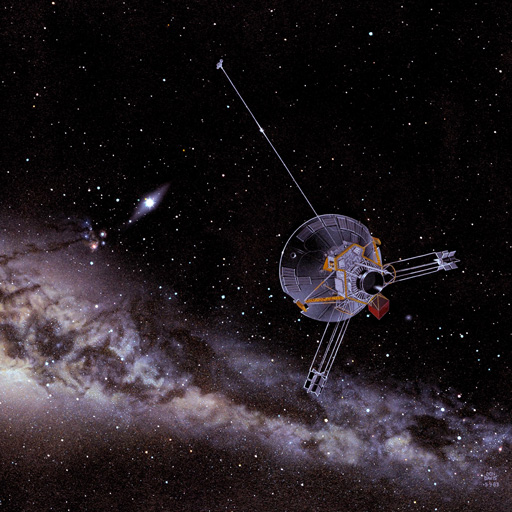
Artist’s impression of a Pioneer spacecraft on its way to interstellar space. Image Credit: NASA
Pioneer

Artist’s concept of Voyager spacecraftImage Credit: NASA
Voyager

Image Credit: NASA
Pioneer Plaque
In addition carrying images of itself and two humans, the plaque mounted aboard Pioneer 10 and 11 showed where an alien civilization could look for Earth.

Image Credit: NASA
Golden Record
Recognizing that the Voyager spacecraft might on some distant day cross paths with an alien civilization, scientists placed a disk on each craft containing information about where Earth is located.
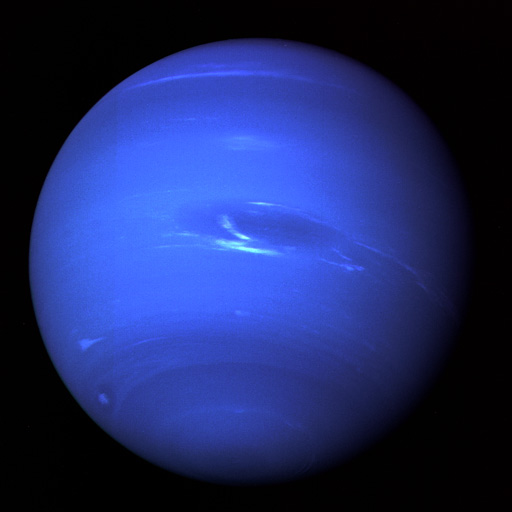
Uranus as seen by Voyager 2Image Credit: NASA
Neptune
At Neptune, Voyager 2 discovered five moons, four rings, and a "Great Dark Spot" that vanished by the time the Hubble Space Telescope imaged Neptune five years later. Neptune's largest moon, Triton, was found to be the coldest known planetary body in the solar system, with a nitrogen ice "volcano" on its surface.
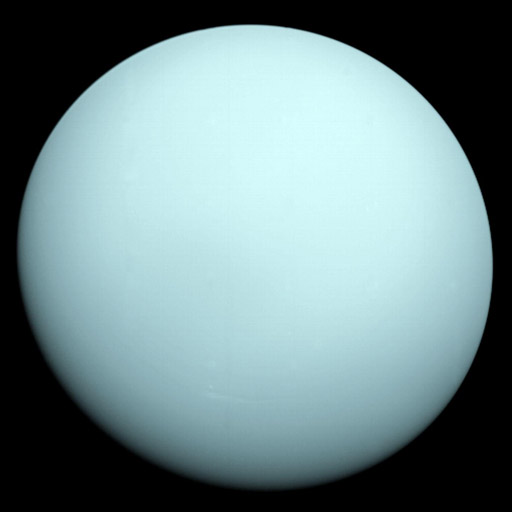
Image Credit: NASA/JPL
Uranus
Data from Voyager 2 showed Uranus’s rotation is 17 hours, 14 minutes. It also discovered 11 moons and two rings that had been previously undetected. The temperature of the equatorial region, which receives less sunlight over a Uranian year, is nevertheless about the same as that at the poles
The Moon
Since NASA first set its sights on the Moon 60 years ago, newer planetary probes continually improve what we can see and learn. The Lunar Reconnaissance Orbiter (LRO), launched in 2009, is providing information that will prove useful for future exploration of the Moon.

Image Credit: NASA
Earthrise
Earthrise over the Moon, image captured by NASA’s LRO from the spacecraft’s vantage point in orbit around the Moon, 2015.

Image Credit: NASA
Topographic Map
A new map of the moon. NASA’s LRO science team released the highest resolution near-global topographic map of the moon ever created. It shows the surface shape and features over nearly the entire moon with a pixel scale close to 328 feet.
Galileo to Jupiter
After Pioneer and Voyager, NASA sent two missions to orbit Jupiter: Galileo and Juno. Galileo took the first samples of the atmosphere of a gas planet, provided data that created the first detailed maps of Jupiter’s major moons, and provided the most detailed look yet at the structure of the planet’s magnetic field and radiation belts. Juno, which entered Jupiter’s orbit in 2016, is studying the origin and evolution of Jupiter.

Image Credit: NASA
Great Red Spot
Jupiter’s Great Red Spot viewed by Voyager 1, 1979. At about 89,000 miles in diameter, Jupiter, the largest planet in the solar system, could swallow 1,000 Earths. The spot is a storm three and a half times the size of our planet. Jupiter’s Great Red Spot may be the mysterious heat source behind the planet’s surprisingly high upper atmospheric temperatures.

Image Credit: NASA
Juno
High above Jupiter’s clouds, NASA’s Juno spacecraft was a little more than one Earth diameter from Jupiter when it captured this color-enhanced view of the planet’s turbulent atmosphere

Image Credit: NASA
Europa
Beneath its icy crust, Jupiter’s Europa has more liquid water than earth. Long, linear cracks and ridges that crisscross the surface indicate disrupted terrain where the surface ice crust has been broken up and re-frozen into new patterns. Although Jupiter is more than 500 million miles away from the sun, the enormous planet’s tides keep its moons warm.
Saturn: Cassini-Huygens
Cassini was a sophisticated spacecraft that explored the Saturnian system from 2004 to 2017. A joint endeavor of NASA, the European Space Agency and the Italian space agency, Cassini taught us that Saturn is a far cry from a tranquil lone planet with delicate rings. We now know more about Saturn’s chaotic, active, and powerful rings, and the storms that rage beneath. Images and data from two of Saturn’s moons hint at the possibility of life never before suspected.
 "NASA’s Cassini spacecraft captured this view of Saturn’s northern hemisphere in 2016, as that part of the planet neared its summer solstice in May 2017. Saturn’s year is nearly 30 Earth years long.
"NASA’s Cassini spacecraft captured this view of Saturn’s northern hemisphere in 2016, as that part of the planet neared its summer solstice in May 2017. Saturn’s year is nearly 30 Earth years long. Image Credit: NASA/Jet Propulsion Laboratory-Caltech/Space Science Institute

Image Credit: NASA/JPL-Caltech/Space Science Institute
Titan
Titan, Saturn’s largest moon, and to its right, Dione, Saturn’s fourth-largest moon, posing before the planet and its rings, viewed from NASA’s Cassini spacecraft on May 21, 2011.
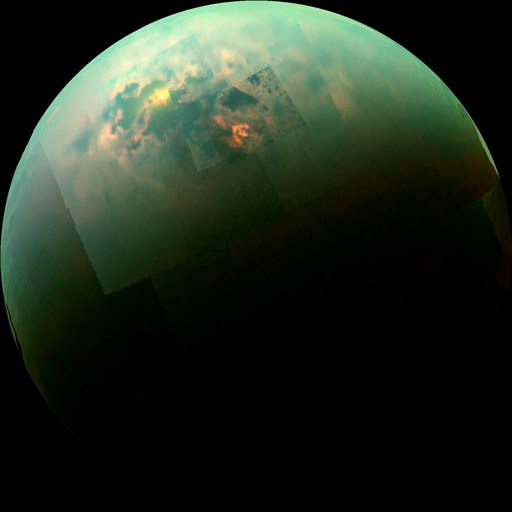
Image Credit: NASA/JPL-Caltech/University of Arizona/University of Idaho
Titan’s North Polar Seas
Near-infrared, color mosaic from NASA’s Cassini spacecraft shows the sun glinting off of Titan’s north polar seas. Titan is the only moon in our solar system that has clouds and a dense atmosphere, mostly made of nitrogen and methane. It is also the only other place in the solar system known to have an earthlike cycle of liquids evaporating, raining, and flowing across its surface. But on Titan, instead of water, the clouds, rain, rivers, seas, and lakes are made of liquid hydrocarbons. The moon’s surface is icy, at hundreds of degrees below freezing.
Asteroids
NASA’s Dawn spacecraft was launched in 2009 to study Vesta and Ceres, two protoplanets—large bodies of matter thought to be developing into planets— located in the asteroid belt between Mars and Jupiter. Vesta is a rocky body, while Ceres is believed to contain large quantities of ice.
 Image Credit: NASA
Image Credit: NASA
Vesta
The giant asteroid Vesta, image synthesized from views taken by Dawn spacecraft, July 2011 to Sept. 2012. The towering mountain at Vesta’s south pole—more than twice the height of Mount Everest—is visible at the bottom of the image. The set of three craters known as the "snowman" can be seen at the top left.
New Horizons at Pluto
Launched on Jan. 19, 2006, New Horizons was NASA’s first mission to the dwarf planet Pluto. After a swing past Jupiter for a gravity boost and scientific studies, the spacecraft conducted a six-month flyby study of Pluto and its moons in 2015. Its next destination is into the Kuiper Belt to examine another of the ancient, icy mini-worlds in that vast region, at least a billion miles beyond Neptune’s orbit.
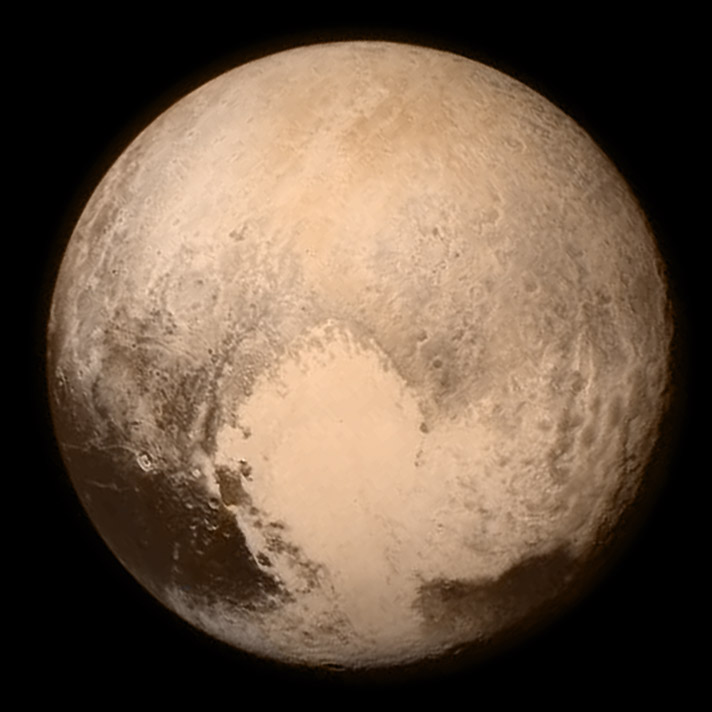 Image Credit: NASA/JHU APL/SWRI
Image Credit: NASA/JHU APL/SWRI
Pluto
Global image of Pluto, taken by NASA’s New Horizons spacecraft, July 13, 2015. We don’t yet know why Pluto is reddish, but chemistry appears to be the reason. Sunlight could cause hydrocarbons, like methane and carbon monoxide, on Pluto’s icy surface and in its chilly atmosphere to combine, forming compounds that rain red-hued materials upon the dwarf planet.
OSIRIS-REx
Late in 2018, the OSIRIS-REx spacecraft will travel to a near-Earth asteroid called Bennu (formerly 1999 RQ36) and bring a sample back to Earth for study. The mission will help scientists investigate how planets formed and how life began, as well as improve our understanding of asteroids that could impact Earth.

This artist's concept shows the OSIRIS-REx spacecraft approaching the asteroid Bennu. Image Credit: NASA
Mercury and Venus

Image of Mercury taken by MESSENGERImage Credit: NASA/Applied Physics Laboratory/Carnegie
Mercury
NASA has sent two missions to Mercury: Mariner 10 and MESSENGER. Among its many accomplishments, MESSENGER determined that Mercury’s surface composition was more similar to that of some kinds of meteorites than to the other planets’, discovered its weak magnetic field provides the planet little protection from the solar wind, and verified its polar deposits are dominantly water ice.
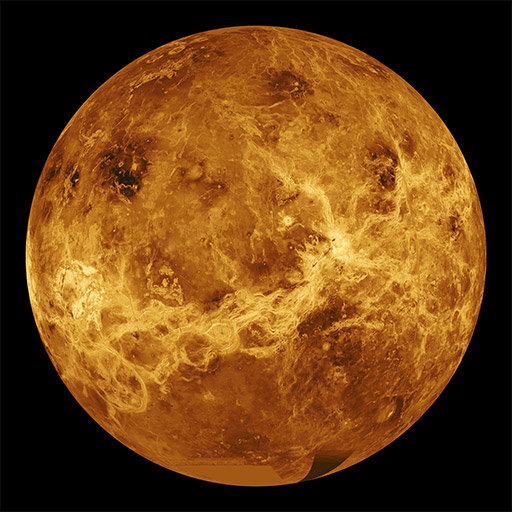
Simulated-color radar image of Venus from Magellan dataImage Credit: NASA/JPL
Venus
Magellan, NASA’s most extensive mission to Venus, used a radar to peer through the planet’s thick cloud cover to return data on its surface. The data showed a planet with covered with volcanic flows, but with no evidence of plate tectonics. Venus’s surface also appears to be relatively young (500 million years), perhaps have been resurfaced by a series of volcanic eruptions at that time.
The Sun

This 2013 image shows a coronal “hole” over the Sun’s north pole.Image Credit: ESA/NASA
SOHO
A joint ESA/NASA mission, SOHO studies the Sun from deep inside its core to the outer corona and solar wind. It has been capturing images of dynamic solar eruptions—such as solar flares and coronal mass ejections—since 1996. Its coronagraphs—telescopes that observe the Sun’s atmosphere by blocking out the bright Sun in the middle—remain a key component for forecasting the speed, direction and strength of coronal mass ejections as they erupt from the Sun. In addition to watching our star, SOHO has become the most prolific discoverer of comets in astronomical history: as of 2016, more than 3,000 comets had been found by SOHO, over half by amateur astronomers accessing the images over the Internet.

A 2013 solar flare seen in different wavelengths by instruments aboard the Solar Dynamics Observatory.Image Credit: NASA/SDO/Wiessinger
Solar Dynamics Observatory
The Solar Dynamics Observatory seeks to understand the Sun as a star and its influence on Earth and near-Earth space by observing the solar atmosphere in many wavelengths simultaneously. The mission studies what creates solar activity that causes various space weather effects.
Deep Space Network

Image Credit: NASA
Map of Deep Space Network (DSN). Three satellite stations, each placed a third of the way around the globe, ensure that any satellite in deep space is able to communicate with at least one station at all times.

